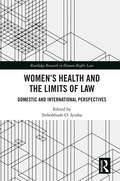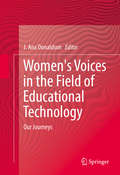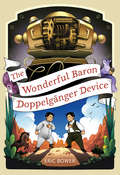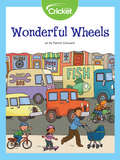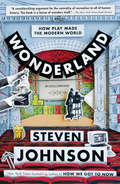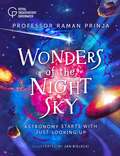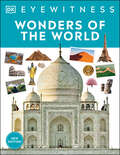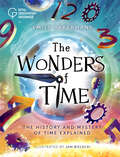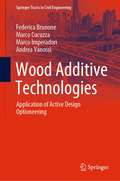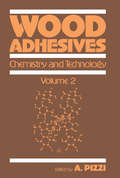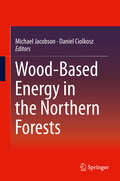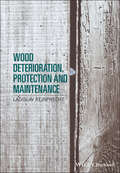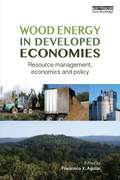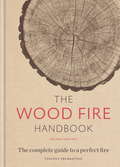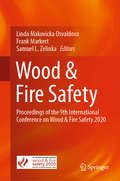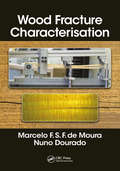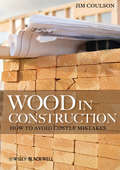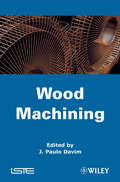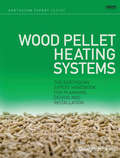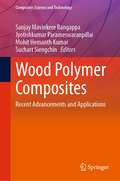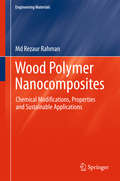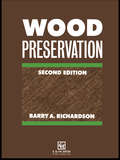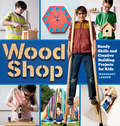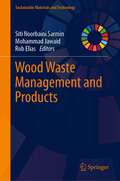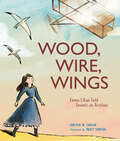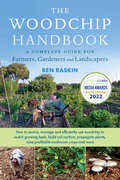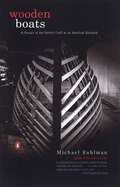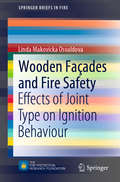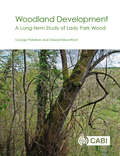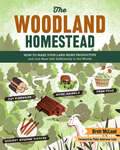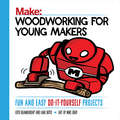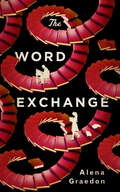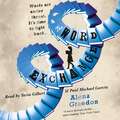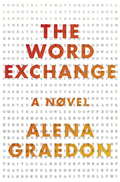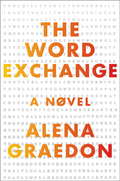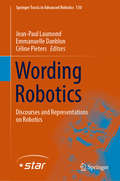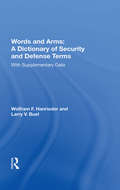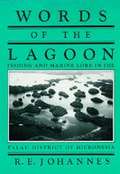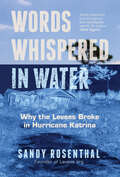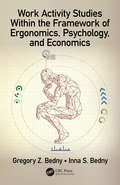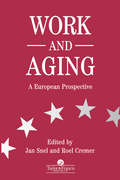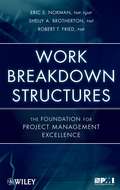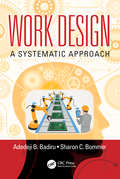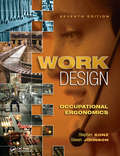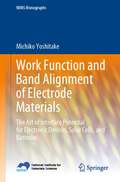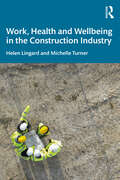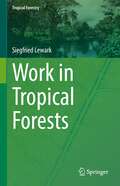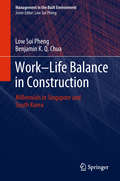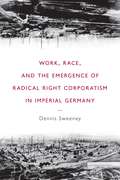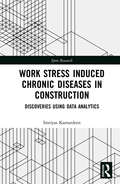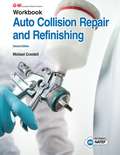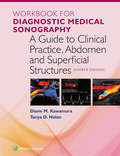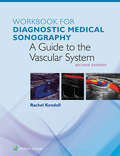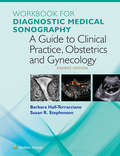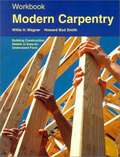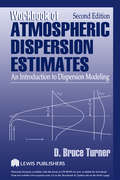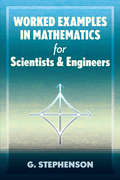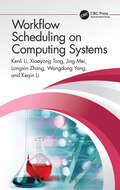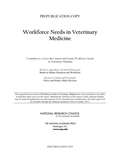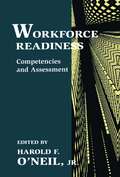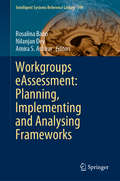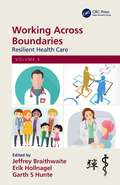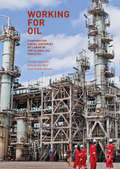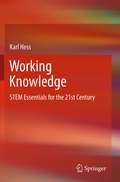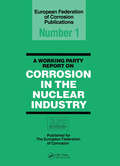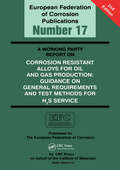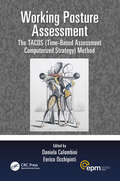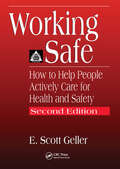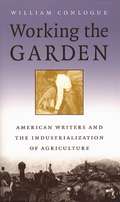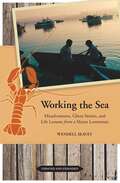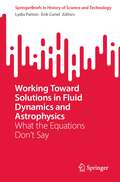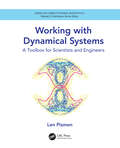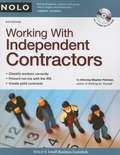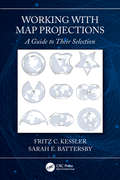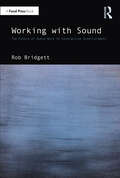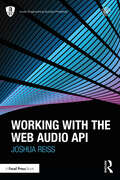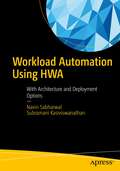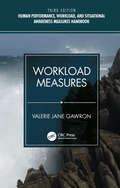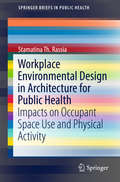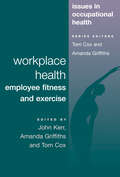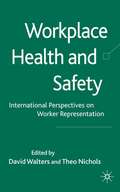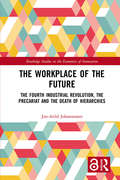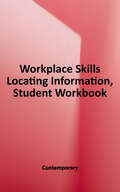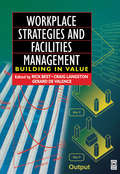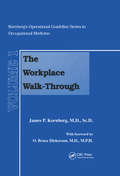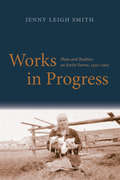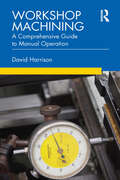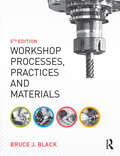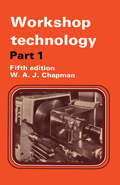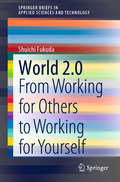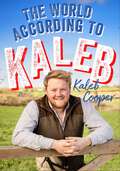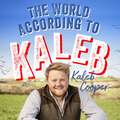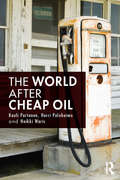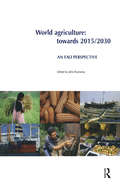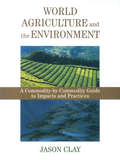- Table View
- List View
Women's Health and the Limits of Law: Domestic and International Perspectives (Routledge Research in Human Rights Law)
by Irehobhude O. IyiohaDespite some significant advances in the creation and protection of rights affecting women’s health, these do not always translate into actual health benefits for women. This collection asks: 'What is an effective law and what influences law’s effectiveness or ineffectiveness? What dynamics, elements, and conditions come together to limit law’s capacity to achieve instrumental goals for women’s health and the advancement of women’s health rights?' The book presents an integrated, co-referential and sustained critical discussion of the normative and constitutive reasons for law’s limited effectiveness in the field of women’s health. It offers comprehensive and cohesive explanatory accounts of law’s limits and for the first time in the field, introduces a distinction between formal and substantive effectiveness of laws. Its approach is trans-systemic, multi-jurisdictional and comparative, with a focus on six countries in North America, Europe, Asia, and Africa and international human rights case law based on matters arising from Hungary, Portugal, Spain, Slovakia, the Czech Republic, Peru and Bolivia. The book will be a valuable resource for educators, students, lawyers, rights advocates and policymakers working in women’s health, socio-legal studies, human rights, feminist legal studies, and legal philosophy more broadly.
Women's Voices in the Field of Educational Technology
by J. Ana DonaldsonIn a professional world that has a tradition of the "good old boy" network, women long have fought for recognition in the educational technology field. In this book authors discuss the women in their own lives who have made the difference for them in their professional development. A group of 31 individuals from the USA, Canada, Northern Cyprus, the UK, and South Korea were asked to be part of this endeavor. The breadth of the list was intended to bring together as many perspectives as possible. Some stories included in this book are deeply private, others offer historical perspectives of women's roles in educational technology, while others focus on mentoring. This book is intended as a resource for all individuals in the field of educational technology, instructional design, and learning design at a national and international level.
The Wonderful Baron Doppelganger Device (The Bizarre Baron Inventions)
by Eric BowerWhen someone gets ahold of the Barons’ Wonderful Doppelgänger Device, which allows them to transform into anyone, they use it to land Rose in jail by posing as her to cause a small explosion during the Pitchfork Fair. The dastardly villain then ambushes W.B. and abducts him onto a train bound for the other side of the country. With W.B. out of the way, the imposter replaces him until W.B. returns unexpectedly and exposes the plot. Unfortunately, the deadly duplicate is great at impersonation. To save his skin, W.B. must prove himself by W.B.ing harder than he’s ever W.B.ed before.
The Wonderful Flight to the Mushroom Planet (Mushroom Planet #1)
by Eleanor CameronChuck and David pay a visit to the Mushroom Planet.
Wonderful Wheels
by Amy TaoWanda Wheel presents the captivating history of wheels, and their influence on civilization.
Wonderland: How Play Made the Modern World
by Steven JohnsonFrom the New York Times-bestselling author of How We Got to Now and Where Good Ideas Come From, a look at the world-changing innovations we made while keeping ourselves entertained. This lushly illustrated history of popular entertainment takes a long-zoom approach, contending that the pursuit of novelty and wonder is a powerful driver of world-shaping technological change. Steven Johnson argues that, throughout history, the cutting edge of innovation lies wherever people are working the hardest to keep themselves and others amused. Johnson's storytelling is just as delightful as the inventions he describes, full of surprising stops along the journey from simple concepts to complex modern systems. He introduces us to the colorful innovators of leisure: the explorers, proprietors, showmen, and artists who changed the trajectory of history with their luxurious wares, exotic meals, taverns, gambling tables, and magic shows. Johnson compellingly argues that observers of technological and social trends should be looking for clues in novel amusements. You'll find the future wherever people are having the most fun.From the Hardcover edition.
Wonders of the Night Sky
by Raman PrinjaInviting all who dare to wonder - come navigate the spectacular treasures of the night sky with bestselling and award-winning Professor Raman Prinja's inspiring look into our galaxy and beyond, published in association with Royal Observatory Greenwich.Encourage your kids to reach for the stars with this inspiring exploration of the night sky. Anyone with a view of the sky and a curious mind can be the next great Universe explorer!Wonders of the Night Sky invites children all over the world to look up - just as curious people before them have done for millennia - and to know why each wonder appears before their eyes. This beautiful book connects readers to the many parts of our Universe visible to the naked eye against the sky, explodes them on the page, then provides inspiring connections to the science behind the stellar backdrop. Professor Raman Prinja is the multi-award-winning Head of Department for Physics and Astronomy at University College London and a celebrated children's author. Professor Prinja pens this definitive look at the wonders above us, following on from the enormous success of his book Planetarium. Illustrator Jan Bielecki's striking depiction of each natural marvel will draw in readers to a lifetime of astronomical wonder. Astronomy starts with just looking up!If you like this, you'll also love the follow-up book, The Future of the Universe. Take what you've learned about the Universe and rocket trillions of years ahead in time to find out some amazing changes to come...
Wonders of the World (DK Eyewitness)
by DKDiscover the astounding ancient architecture, the history of civilization, and the beauty of our planet in these Wonders of the World.Become an eyewitness to the fascinating architectural feats and natural treasures of the world in this picture-led reference guide that will take you on a visual tour of more than 50 wonders of the world. Children will be mesmerized by human-made landscapes such as the Statue of Liberty to record-breaking natural marvels like the River Nile. This unique, beautifully illustrated guide takes kids on an incredible journey around the world's most spectacular sights. Using striking full-color photographs and illustrations, discover the Pyramids of Giza, the Hanging Gardens of Babylon, the Temple of Artemis, the Statue of Zeus, the Mausoleum atHalicarnassus, the Colossus of Rhodes, and the Lighthouse of Alexandria and much more!Throughout the pages of this newly-revised book on Wonders of the World, you can expect to find: - A fresh new look, new photographs, updated information, and a new &“eyewitness&” feature- Amazing facts, diagrams, statistics, and timelines- Brand new eyewitness accounts from experts in the fieldEyewitness Wonders of the World introduces the ultimate guide to remarkable architecture and natural wonders. Children can learn about the most incredible natural and human-made wonders, through amazing facts, diagrams, and statistics to see them as never before. This all-emcompassing wonders of the world guide is a must-have for curious children aged 9+ with a thirst for learning, as well as teachers, parents and librarians.So, what&’s new? Part of DK&’s best-selling Eyewitness series, this popular title has been reinvigorated for the next generation of information-seekers and stay-at-home explorers, with a fresh new look, up to 20 percent new images, including photography and updated diagrams, updated information, and a new &“eyewitness&” feature with fascinating first-hand accounts from experts in the field.Explore the series!Globally, the Eyewitness series has sold more than 50 million copies over 30 years. Journey down the River Amazon and explore the rainforest with Eyewitness Amazon, learn how to combat climate change with Eyewitness Climate Change or take a trip aboard the most famous ship in history with Eyewitness Titanic.
The Wonders of Time
by Emily AkkermansIt's time for a mind-blowing look at the history and mystery of time with the masters of timekeeping - travelling across the globe and even to the far reaches of space!The Wonders of Time is written by the expert Curator of Time at the home of timekeeping, Royal Observatory Greenwich. The book uncovers the history and mysteries of time: its beginnings, the methods of measuring it, how we experience it, different philosophies of time and the potential of time travel. Readers explore the timeline of timekeeping, looking at the evolution of our understanding from the Big Bang to today.Just some of the astonishing contents of The Wonders of Time: - The beginning of time in the Universe, on Earth and measuring time on other planets in the solar system- The shape of time (is it a circle? a line? a spiral?) and our natural body clocks- The invention of timekeeping straight through to quartz and atomic clocks- Coordinating timezones across the world- Record-breakers in time: lifespans in humans and animals- Considering our human urge to capture moments in time (take a photo! bury a time capsule!)- Take a tour of seven amazing clocks from around the worldThis is the third book in a series published by Wayland in association with Royal Observatory Greenwich exploring the wonders of science, illustrated by the super-creative Jan Bielecki. Other books in the series include: Wonders of the Night Sky and The Future of the Universe by Professor Raman Prinja.
Wood Additive Technologies: Application of Active Design Optioneering (Springer Tracts in Civil Engineering)
by Marco Imperadori Federica Brunone Marco Cucuzza Andrea VanossiThe book encodes a vision for the actively sustainable management and development of the built environment by referring to the application of timber-based construction systems as additive solutions for the multi-purpose improvement of existing buildings. It translates this vision into an innovative methodology for the management of the entire building process – from design to production, operation, and maintenance - and the assessment of timber-based construction performances across the whole building life-cycle. This approach is based on a multi-dimensional analysis, which starts from the structure of the Active House (AH) protocol, improved through information-integrated digital environments and multi-criteria evaluation methods, such as BIM and Design Optioneering. During the design stage, indeed, it analyzes and compares different design choices, according to the DO method, until the definition and validation of the “As-Built” step, while in the operational phase, it refers to sensors-retrieved data to show the evolution of the building behaviour, accounting for real users’ interaction, building performances decay and needs of maintenance, defining the digital twin of the building: a real Cognitive Building. Finally, the application of this methodology identifies innovative models of processes, products, and design of wood-based construction technologies, suitable to satisfy the needs of the 2D/3D construction layering for the sustainable transformation of the built environment.
Wood Adhesives: Chemistry and Technology---Volume 2
by A. PizziThe perfect companion to the highly acclaimed Volume 1 of Wood Adhesives,Volume 2 presents stimulating discussions on technically and economically importantadhesives for wood bonding-covering their preparation and formulation, as well astechniques and suggestions for their application.Like its companion book, Wood Adhesives, Volume 2 provides up-to-date informationand analysis of new technologies and recent breakthroughs ... gives insightinto the relationship between adhesive chemistry and technical application . . . anddiscusses present and future trends likely to have considerable impact on the field.Elaborating upon general overviews presented in Volume 1, Wood Adhesives,Volume 2 includes a chapter on protein adhesives ... fills the gap on the chemistryof polyvinyl acetate wood adhesives ... contains a detailed discussion of formaldehydeemission ... and much more.A complementary and much needed follow-up to Volume 1, Wood Adhesives,Volume 2 is essential reading for wood technologists; adhesives and physicalchemists; forest products researchers; polymer scientists; chemical, mechanical, process,and civil engineers who must choose and apply wood adhesives; and advancedundergraduate and graduate students in the above disciplines.
Wood-Based Energy in the Northern Forests
by Michael Jacobson Daniel CiolkoszThis unique book provides the first comprehensive overview of wood based bioenergy in the northern hardwood forests of the Eastern United States. This includes a holistic look at the topic of wood based bioenergy, as well as focused analyses of key topics. This book is relevant to engineers, project developers, foresters, economists, sociologists, environmental scientists and natural resource managers. Most chapters also provide practical hands-on advice for the practitioner, and provide a valuable resource for anyone who is considering developing a woody bioenergy project.
Wood Deterioration, Protection and Maintenance
by Ladislav ReinprechtWood Deterioration, Protection and Maintenance provides an up to date discussion of the natural durability of wood, wood degradation processes, and methods of structural and chemical protection of wood. Modern active substances in wood preservatives and the relationships between preservative properties, the anatomical structure and moisture content of wood and protective processes involving pressure and/or diffusion driving forces are fully illustrated.
Wood Energy in Developed Economies: Resource Management, Economics and Policy
by Francisco X. AguilarThere has been a recent resurgence of interest in wood energy as part of a sustainable range of renewable energy options. This book addresses the current gap in the energy and public policy literature for a reference book that compiles the most-recent wood energy assessments, and evaluates current and potential future wood energy uses and the role for public policy to foster efficient use of the most-widely consumed renewable energy in the world. It brings together a group of expert authors covering topics from forest management, operations and engineering, to socio-economics and energy policy perspectives. It thus covers practical issues such as silviculture, harvesting, processing, comparative cost estimates, public policy tools and market effects. As such the book provides a comprehensive review of the complex dimensions of wood energy as well as practical guidance for professionals, researchers and advanced students. It will also provide invaluable guidance for economic development agencies, practitioners and policy-makers, when evaluating the impacts of wider wood energy adoption as part of a strategy for sustainable energy generation. The main focus is on industrialised production and developed economies, particularly the USA and Europe.
The Wood Fire Handbook: The complete guide to a perfect fire
by Vincent Thurkettle'Sound, well-seasoned advice [on] how to bring wood fires into our lives.' - BBC CountryfileThe Wood Fire Handbook shows you that the soothing effect of dancing flames and glowing embers is a simple pleasure to have in our lives. Understanding everything that underpins the perfect wood fire makes it even more enjoyable. Vincent Thurkettle's handbook is the essential companion and manual.The expert insight and knowledge in this book allow everyone to rediscover the skills of previous generations and savour the delight of a perfect wood fire in all its incarnations.Contents include...Understand which trees make the best firewoodLearn how to split, season, and store woodLay the perfect fireMake an ingenious campfireChoose wood for its scent...and much more!This revised edition features updated information on wood-burning stoves, 'clean' wood and other environmental considerations.
The Wood Fire Handbook: The complete guide to a perfect fire
by Vincent Thurkettle'Sound, well-seasoned advice [on] how to bring wood fires into our lives.' - BBC CountryfileThe Wood Fire Handbook shows you that the soothing effect of dancing flames and glowing embers is a simple pleasure to have in our lives. Understanding everything that underpins the perfect wood fire makes it even more enjoyable. Vincent Thurkettle's handbook is the essential companion and manual.The expert insight and knowledge in this book allow everyone to rediscover the skills of previous generations and savour the delight of a perfect wood fire in all its incarnations.Contents include...Understand which trees make the best firewoodLearn how to split, season, and store woodLay the perfect fireMake an ingenious campfireChoose wood for its scent...and much more!This revised edition features updated information on wood-burning stoves, 'clean' wood and other environmental considerations.
Wood & Fire Safety: Proceedings of the 9th International Conference on Wood & Fire Safety 2020
by Linda Makovicka Osvaldova Frank Markert Samuel L. ZelinkaThis proceedings volume presents new scientific works of the research workers and experts from the field of Wood Science & Fire.It looks into the properties of various tree species across the continents affecting the fire-technical properties of wood and wood-based materials, its modifications, fire-retardant methods and other technological processes that have an impact on wood ignition and burning. The results of these findings have a direct impact on Building Construction and Design describing the fire safety of wooden buildings, mainly large and multi-story ones. The results of these experiments and findings may be applied, or are directly implemented into Fire Science, Hazard Control, Building Safety which makes the application of wood and wood materials in buildings possible, while maintaining strict fire regulations.One part of the contributions focuses on the symbiosis of the material and the fire-fighting technologies. Wood burning has its own specific features, therefore, the fire protection technologies need to be updated regularly. It also includes the issue of the intervention of fire-fighting and rescue teams in the fires of wooden buildings. Presentations deal with the issue of forest fires influenced by the climate changes, relief, fuel models based on the type and the age of the forest stand.
Wood Fracture Characterization
by Marcelo F. de Moura Nuno DouradoWood Fracture Characterization provides a guide to the application of modern fracture mechanics concepts to wood materials used in structural engineering, which commonly involve discontinuities and irregularities. The authors cover the tests, data reduction schemes and numerical methods devised for wood structural applications, based on cohesive zone analysis, and used to validate experimental-based methodologies. Five detailed Case Studies are included to link theory with engineering practice. This important new text explains the basics of fracture mechanics, and extends them as needed to cover the special behaviour of an anisotropic wood materials.
Wood in Construction: How to Avoid Costly Mistakes
by Jim CoulsonWood in Construction – How to Avoid Costly Mistakes focuses on the basic principles and appropriate use of wood in construction and illustrates how to avoid or minimise problems, to ensure that wood performs as expected when used in a construction application. Based on the author’s extensive experience of manufacturing processes and practical applications in the timber, construction, joinery, shop-fitting and furniture industries, Wood in Construction provides a guide to using wood in building in the real world. It describes the main causes of difficulty when using wood, and shows how to avoid or minimise problems, reducing the difficulties for the architect, engineer or specifier, builder and building owner. Technical enough to explain why things should be done in specific ways, but also practical enough to demonstrate how to use wood correctly and avoid doing the wrong things, this is an invaluable resource for construction specifiers (architects, engineers), carpenters, structural engineers, building surveyors, small/medium sized builders.
Wood Machining
by J. Paulo DavimWood as an engineering material can be technically defined “as a hygroscopic, orthotropic, biological, and permeable material having extreme chemical diversity and physical complexity with structures, that vary extensively in their shape, size, properties and function”. Therefore, using wood to its best advantage and most efficiency in engineering applications, specific characteristics or chemical, physical and mechanical properties must be considered. The products are divided into two classes, solid wood and composite wood products. Solid wood includes shipbuilding, bridges, flooring, mine timbers, etc. Composite wood products include insulation board, plywood, oriented strand board, hardboard and particle board. In recent years, the machining of wood products has acquired great importance due the short supply of wood and increasing environmental awareness among users and manufacturers. The optimization of the machining process centers around the mechanism of chip formation, tool wear, workpiece surface quality, crack initiation and propagation of different types of wood. Other factors are also humidity, temperature, static preloads, and vibrations that can affect the wood during the machining process. The book provides some fundamentals and recent research advances on machining wood and wood products.
Wood Pellet Heating Systems: The Earthscan Expert Handbook on Planning, Design and Installation (Earthscan Expert Ser.)
by Dilwyn JenkinsWood Pellet Heating Systems is a comprehensive handbook covering all aspects of wood pellet heating technology. The use of wood pellets as an alternative heating fuel is already well established in several countries and is becoming widespread as fossil fuel prices continue to rise and awareness of climate change grows. Wood pellets are a carbon-neutral technology, convenient to use, and can easily be integrated into existing central heating systems or used in independent space heaters. This fully-illustrated and easy-to-follow guide shows how wood-pellet heating works, the different types of systems – from small living room stove systems to larger central heating systems for institutions – how they are installed, and even how wood pellets are manufactured. Featuring examples from around the world, it has been written for heating engineers and plumbers who are interested in installing systems, home owners and building managers who are considering purchasing a system, advanced DIYers, building engineers and architects, but will be of interest to anyone who requires a clear guide to wood pellet technology.
Wood Polymer Composites: Recent Advancements and Applications (Composites Science and Technology)
by Sanjay Mavinkere Rangappa Jyotishkumar Parameswaranpillai Mohit Hemanth Kumar Suchart SiengchinThis book comprehensively covers the different topics of wood polymer composite materials mainly synthesis methods for the composite materials, various characterization techniques to study the superior properties and insights on potential advanced applications. It also discusses the chemistry, fabrication process, properties, applications, recycling and life cycle assessment of wood polymer composites. This is a useful reference source for both engineers and researchers working in composite materials science as well as the students attending materials science, physics, chemistry and engineering courses.
Wood Polymer Nanocomposites
by Md Rezaur RahmanThis book shows how chemical modifications influence some properties of wood nanocomposites. It describes suitable and effective chemical modifications that strengthen the physico-mechanical, thermal and morphological properties of wood. The authors provide intuitive explanation of the various types of chemical modifications applied to polymer cell walls in wood. They emphasize the reaction changes in wood cell walls due to the chemical modifications. Increased mechanical strength, improved thermal stability as well as the efficient retardancy against fungi attack are described. This book concludes summarizing the potential applications of wood-based nanocomposites taking into account sustainability and economic aspects.
Wood Preservation
by B A RichardsonThe new edition of this comprehensive study of national and international research and application into wood preservation is both well detailed and broad in coverage. The text covers the history of preservation: the anatomy of timbers and their breakdown, preservation principles, materials and methods.
Wood Shop: Handy Skills and Creative Building Projects for Kids
by Margaret LarsonCome on, kids: grab a hammer, step up to the workbench, and get ready to measure, saw, drill, and make cool things! Wood Shop is an exciting introduction for today’s kids to an age-old tradition: building with wood. With step-by-step photographs and clear instructions, aspiring woodworkers learn essential skills such as how to drive a nail, use a power drill, “measure twice, cut once,” and saw correctly. Then the fun begins, with 17 cool and creative projects kids can build to furnish the wood shop, decorate their bedrooms and homes, and create their own play equipment. Favorite projects include Tic-Tac-Toe-To Go!, One-Board Birdhouse, a Tool Tote, and a hanging Twinkle Light. Wood Shop is the perfect gift for tinkerers, young makers, fans of LEGO toys, and aspiring carpenters and engineers. This publication conforms to the EPUB Accessibility specification at WCAG 2.0 Level AA.
Wood Waste Management and Products (Sustainable Materials and Technology)
by Siti Noorbaini Sarmin Mohammad Jawaid Rob EliasThis book examines the application of wood waste in various advancements in environmental fields, such as construction, renewable energy, bio-absorbent, and agricultural and wood-based material. Featuring illustrations, and tables summarizing the latest research, it gathers up-to-date information on the application of various types of wood waste which could be applied in a practical manner to materially reduce nuisance created by fallout of wood-based industries from different sources. Given its scope, the book is a valuable reference book for research students and reference resources for researchers, academics, and industrial scientists working in the field of wood waste management and their utilization.
Wood, Wire, Wings: Emma Lilian Todd Invents an Airplane
by Kirsten W. LarsonThis riveting nonfiction picture book biography explores both the failures and successes of self-taught engineer Emma Lilian Todd as she tackles one of the greatest challenges of the early 1900s: designing an airplane.Emma Lilian Todd's mind was always soaring--she loved to solve problems. Lilian tinkered and fiddled with all sorts of objects, turning dreams into useful inventions. As a child, she took apart and reassembled clocks to figure out how they worked. As an adult, typing up patents at the U.S. Patent Office, Lilian built the inventions in her mind, including many designs for flying machines. However, they all seemed too impractical. Lilian knew she could design one that worked. She took inspiration from both nature and her many failures, driving herself to perfect the design that would eventually successfully fly. Illustrator Tracy Subisak's art brings to life author Kirsten W. Larson's story of this little-known but important engineer.
The Woodchip Handbook: A Complete Guide for Farmers, Gardeners and Landscapers
by Ben RaskinThe first and only complete guide to sourcing and using woodchip—an abundant, inexpensive, and ecologically sustainable material—for savvy growers and landscapers at any scale, from farm to garden to greenhouse. The Woodchip Handbook is the essential guide to the many uses of woodchip both in regenerative agriculture and horticulture. Author Ben Raskin, Head of Horticulture and Agroforestry at the Soil Association, draws on his extensive practical experience using woodchip, provides the latest research from around the world, and presents inspiring case studies from innovative farmers. The book explores and unlocks the tremendous potential of woodchip to enhance soil health and plant growth: As a natural mulch for weed suppression, temperature buffering, and water conservation As a growing medium for propagating plants As a decomposing source of warmth for hotbeds in the greenhouse or hoop house As a carbon-rich compost ingredient that supports beneficial fungi and microorganisms As a powerful soil health booster, when applied as small-sized ramial chipped wood As an ideal substrate for growing many kinds of edible or medicinal mushrooms As a sustainable, versatile, and durable material for foot paths and ornamental landscaping Some of these techniques, like mulching—or the renewable harvest potential from coppicing and pollarding trees—have been around forever. Yet there is always new science to be discovered, such as the role that salicylic acid from willow woodchip can play in preventing tree diseases or promoting livestock health when used as a bedding material. Whether you are a commercial grower or farmer, a permaculture practitioner, or a serious home gardener producing your own fruit and vegetables, The Woodchip Handbook will show you how to get the most out of this readily available and renewable material.
Wooden Boats: In Pursuit of the Perfect Craft at an American Boatyard
by Michael RuhlmanThere are fewer than 10,000 wooden boats in America, but the circulation of WoodenBoat magazine exceeds 180,000. What is it about these boats that has captured the popular imagination? With his "lively blend of reportage [and] reflection" (Los Angeles Times), Michael Ruhlman sets off for a renowned boatyard in Martha's Vineyard to follow the construction of two boats-Rebecca, a 60-foot modern pleasure schooner, and Elisa Lee, a 32-foot powerboat. Filled with exquisite details and stories of the sea, this exciting exploration of a nearly forgotten craft and the colorful personalities involved will enthrall wooden boat owners as well as craftspeople of every stripe, nature enthusiasts, and fans of compelling nonfiction.
Wooden Façades and Fire Safety: Effects of Joint Type on Ignition Behaviour (SpringerBriefs in Fire)
by Linda Makovicka OsvaldovaThis book presents the results of an experiment assessing the impact of spruce wood joints on the creation and development of fire when these joints are applied within a façade. The book includes an extensive analysis of wooden cladding, which is a flammable material in which the elements are connected lengthwise using various types of joint. The parameters of the experiment, as well as the setting, material criteria and evaluation criteria are described in detail. The results confirm that the joint type used has an impact on the selected evaluation criteria and thus also on the potential spread of fire.
Woodland Development
by George F. Peterken Edward P. MountfordIn 1944 Lady Park Wood (45 hectares of woodland in Gloucestershire and Monmouthshire, UK) was set aside indefinitely by the Forestry Commission so that ecologists could study how woodland develops naturally. Since then, in a unique long-term study, individual trees and shrubs have been recorded at intervals, accumulating a detailed record of more than 20,000 individual beech, sessile oak, ash, wych elm, small-leaved lime, large-leaved lime, birch, hazel, yew and other species. In the seven decades since the study started, the wood has changed; trees grew, died and regenerated, and drought, disease and other events shaped its destiny. Each tree and shrub species reacted in its own way to changes in the wood as a whole and to changes in the fortunes of its neighbours. Meanwhile, the wild fauna, flora and fungi also responded, leaving the wood richer in some groups but poorer in others. In this landmark book, beautifully illustrated throughout, George Peterken and Edward Mountford, summarise the ongoing results of the Lady Park Wood study, highlighting its unique place in nature conservation and its significance to ecology in general. It also builds on experience at Lady Park Wood and elsewhere to discuss in particular: the role and maintenance of long-term ecological studies; the concept and form of natural woodland; the role of minimum-intervention policies in woodland nature conservation; near-to-nature forestry; and the desirability and practicalities of re-wilding woodlands.
Woodland Development: A Long-term Study of Lady Park Wood
by George Peterken Edward MountfordIn 1944 Lady Park Wood (45 hectares of woodland in Gloucestershire and Monmouthshire, UK) was set aside indefinitely by the Forestry Commission so that ecologists could study how woodland develops naturally. Since then, in a unique long-term study, individual trees and shrubs have been recorded at intervals, accumulating a detailed record of more than 20,000 individual beech, sessile oak, ash, wych elm, small-leaved lime, large-leaved lime, birch, hazel, yew and other species. In the seven decades since the study started, the wood has changed; trees grew, died and regenerated, and drought, disease and other events shaped its destiny. Each tree and shrub species reacted in its own way to changes in the wood as a whole and to changes in the fortunes of its neighbours. Meanwhile, the wild fauna, flora and fungi also responded, leaving the wood richer in some groups but poorer in others. In this landmark book, beautifully illustrated throughout, George Peterken and Edward Mountford, summarise the ongoing results of the Lady Park Wood study, highlighting its unique place in nature conservation and its significance to ecology in general. It also builds on experience at Lady Park Wood and elsewhere to discuss in particular: the role and maintenance of long-term ecological studies; the concept and form of natural woodland; the role of minimum-intervention policies in woodland nature conservation; near-to-nature forestry; and the desirability and practicalities of re-wilding woodlands.
The Woodland Homestead: How to Make Your Land More Productive and Live More Self-Sufficiently in the Woods
by Philip Ackerman-Leist Brett McLeodPut your wooded land to work! This comprehensive manual shows you how to use your woodlands to produce everything from wine and mushrooms to firewood and livestock feed. You’ll learn how to take stock of your woods; use axes, bow saws, chainsaws, and other key tools; create pasture and silvopasture for livestock; prune and coppice trees to make fuel, fodder, and furniture; build living fencing and shelters for animals; grow fruit trees and berries in a woodland orchard; make syrup from birch, walnut, or boxelder trees; and much more. Whether your property is entirely or only partly wooded, this is the guide you need to make the best use of it.
Woodworking for Young Makers: Fun and Easy Do-It-Yourself Projects
by Loyd Blankenship Lane BoydLearning to be a maker has never been more fun. Full-color cartoons and drawings lead you through the steps needed for making a wizard wand, a sanding block, a charging station for your phone or tablet, and a sturdy box with a hidden compartment. You'll learn how to choose and use the right tools, measure and cut properly, sand, glue, and finish your woodworking projects to make them look great.This is the perfect guide for young people who want to do woodworking at home, at school, or at a local makerspace. It teaches fundamental skills and unlocks creativity. No prior experience or knowledge of tools is required. Everything you need to know is explained in the text and cartoons.This easy-to-follow guide is suitable for all ages. It features:Lavish cartoons and line artStep-by-step instructions with full-color artProjects that are fun and usefulBasic skills, handy tips, and safety precautionsWoodworking is the most universally useful of crafts. In this book, young adults will learn to work successfully with standard hand tools found in any garage or basement workshop and in any school shop class. The skills learned here will unlock a lifetime of useful skills and satisfying accomplishments.
The Word Exchange
by Alena Graedon'Spine-tingling' New York Times'A fast-paced, thrill-a-minute début novel' New Yorker'Graedon knows how to ratchet up mystery' EsquireWORDS ARE UNDER THREAT. IT'S TIME TO FIGHT BACK...Imagine a world without words. A world in which books, libraries and newspapers are things of the past. A world where personal devices provide all you could want or need.Anana Johnson and her father, Doug, are hard at work on the final edition that will ever be printed of the English Dictionary. But one evening, Doug disappears and Anana unearths a single written clue: ALICE.In the battle to save her father, Anana discovers secret societies, dark incinerator rooms and underground passages. Above all, she finds a world that faces ruin from the dark side of technology. Praise for The Word Exchange'A nervy, nerdy dystopian thriller' New York Times Book Review'A propulsive, twisty future-noir' Daily Beast'Spectacular' Karen Russell, author of Swamplandia! and Vampires in the Lemon Grove'Dazzling' Slate'Wildly ambitious, darkly intellectual and inventive' Kirkus Reviews, starred review
The Word Exchange
by Alena GraedonIn the not-so-distant future, the forecasted 'death of print' has become a reality. Bookstores, libraries, newspapers, and magazines are a thing of the past, as we spend our time glued to handheld devices called Memes that not only keep us in constant communication but have become so intuitive as to hail us taxis before we leave our offices, order takeout at the first growl of a hungry stomach, and even create and sell language itself in a marketplace called the Word Exchange.Anana Johnson works with her father, Doug, at the North American Dictionary of the English Language(NADEL), where Doug is hard at work on the final edition that will ever be printed. Doug is an intellectual who fondly remembers the days when people used e-mail to communicate - or even actually spoke to one another. One evening, Doug disappears from the NADEL offices, leaving a single written clue: ALICE. It's a code word he and Anana devised to signal if one of them ever fell into danger....Joined by Bart, her bookish NADEL colleague (who is secretly in love with her), Anana's search for her father will take her into dark basement incinerator rooms, underground passages of the Mercantile Library, meetings of a secret society designed to save the written word, the boardrooms of the evil online retailing giant Synchronic, and ultimately to the hallowed halls of the Oxford English Dictionary - the spiritual home of the written word. As Anana pieces together what is going on, and Bart falls victim to the strange 'word flu' that is spreading worldwide, the very future of language is at stake....Read by Tavia Gilbert and Paul Michael Garcia(p) 2014 Blackstone Audio
The Word Exchange
by Alena GraedonA fiendishly clever dystopian novel for the digital age, The Word Exchange is a fresh, stylized and decidedly original debut about the dangers of technology and the power of the printed word. In the not so distant future, the forecasted "death of print" has become a reality. Bookstores, libraries, newspapers and magazines are a thing of the past, as we spend our time glued to handheld devices called Memes that not only keep us in constant communication, but have become so intuitive as to hail us cabs before we leave our offices, order take out at the first growl of a hungry stomach, and even create and sell language itself in a marketplace called The Word Exchange. Anana Johnson works with her father Doug at the North American Dictionary of the English Language (NADEL), where Doug is hard at work on the final edition that will ever be printed. Doug is a staunchly anti-Meme, anti-tech intellectual who fondly remembers the days when people used email (everything now is text or video-conference) to communicate--or even actually spoke to one antoher for that matter. One evening, Doug disappears from the NADEL offices leaving a single writen clue: ALICE. It's a code word he and Anana devised to signal if one of them ever fell into harm's way. And thus begins Anana's journey down the proverbial rabbit hole. . . Joined by Bart, her bookish NADEL colleague (who is secretly in love with her), Anana's search for Doug will take her into dark basement incinerator rooms, underground passages of the Mercantile Library, secret meetings of the anonymous "Diachronic Society," the boardrooms of the evil online retailing site Synchronic, and ultimately to the hallowed halls of the Oxford English Dictionary--the spiritual home of the written word. As Ana pieces togehter what is going on, and Bart gets sicker and sicker with the strange "Word flu" that has spread worldwide causing people to speak in gibberish, Alena Graedon crafts a fresh, cautionary tale that is at once a technological thriller, and a throughtful meditation on the price of technology and the unforeseen, though very real, dangers of the digital age.
The Word Exchange
by Alena GraedonA dystopian novel for the digital age, The Word Exchange offers an inventive, suspenseful, and decidedly original vision of the dangers of technology and of the enduring power of the printed word. In the not-so-distant future, the forecasted "death of print" has become a reality. Bookstores, libraries, newspapers, and magazines are things of the past, and we spend our time glued to handheld devices called Memes that not only keep us in constant communication but also have become so intuitive that they hail us cabs before we leave our offices, order takeout at the first growl of a hungry stomach, and even create and sell language itself in a marketplace called the Word Exchange. Anana Johnson works with her father, Doug, at the North American Dictionary of the English Language (NADEL), where Doug is hard at work on the last edition that will ever be printed. Doug is a staunchly anti-Meme, anti-tech intellectual who fondly remembers the days when people used email (everything now is text or videoconference) to communicate--or even actually spoke to one another, for that matter. One evening, Doug disappears from the NADEL offices, leaving a single written clue: ALICE. It's a code word he devised to signal if he ever fell into harm's way. And thus begins Anana's journey down the proverbial rabbit hole . . . Joined by Bart, her bookish NADEL colleague, Anana's search for Doug will take her into dark basements and subterranean passageways; the stacks and reading rooms of the Mercantile Library; and secret meetings of the underground resistance, the Diachronic Society. As Anana penetrates the mystery of her father's disappearance and a pandemic of decaying language called "word flu" spreads, The Word Exchange becomes a cautionary tale that is at once a technological thriller and a meditation on the high cultural costs of digital technology.From the Hardcover edition.o aphasia, Alena Graedon crafts a fresh, cautionary tale that is at once a technological thriller and a thoughtful meditation on the price of technology and the unforeseen, though very real, dangers of the digital age.From the Hardcover edition.
Wording Robotics: Discourses and Representations on Robotics (Springer Tracts in Advanced Robotics #130)
by Jean-Paul Laumond Emmanuelle Danblon Céline PietersRobots challenge humans’ beliefs and expectations. Hence, regardless of whether they are the audience of a conference, the visitors of a lab, the citizens in general, some journalists, or the European Parliament, the first step in order to gain a better understanding of the field of robotics is obviously to consult the experts. Roboticists seem indeed to be in the best position to guide society in this matter, whether it is in the everyday life or within an official institution. Today however, there is a gap between the robots, as they are actually thought and built, and the intelligent and autonomous machines, as they are perceived by the society. How can we explain it? Do the words borrowed from the living organisms and used to describe robots play a role in the confusion about the status of the discipline of robotics? The texts gathered within this book focus on the problematic of wording robotics from various perspectives. They are the results of a unique interdisciplinary meeting gathering roboticists, linguists, philosophers and neuroscientists, the 4th Workshop of Anthropomorphic Motion Factory held at LAAS-CNRS in Toulouse on Nov 31st - Dec 1st 2017.
Words And Arms: With Supplementary Data
by Wolfram F HanriederThis comprehensive dictionary of terms frequently used in discussions of national security and defense policy contains approximately 800 entries on weapons systems, strategy concepts, military organization, and related items. Part 2 presents a more extensive treatment of such concepts as strategic force doctrine and deployment, Soviet and U.S. poli
Words of the Lagoon: Fishing and Marine Lore in the Palau District of Micronesia
by R. E. Johannes"Johannes' book ... beautifully illustrates the encyclopedic knowledge of practical sea lore possessed by traditional fishers, a knowledge that may still not be equaled by the scientific inventory of reef life in many island groups." - William C. Clarke, The Contemporary Pacific
Words Whispered in Water: Why the Levees Broke in Hurricane Katrina
by Sandy Rosenthal&“Anyone who is interested in Hurricane Katrina, and in America&’s failing infrastructure, will want to read this book . . . a fast-paced narrative.&” —Scott G. Knowles, Drexel University2020 Nautilus Silver Winner In the aftermath of one of the worst disasters in US history, Words Whispered in Water tells the story of one woman&’s fight, against all odds, to expose a mammoth federal agency—and win. In 2005, the entire world watched as a major US city was nearly wiped off the map. The levees ruptured and New Orleans drowned. But while newscasters attributed the New Orleans flood to &“natural catastrophes&” and other types of disasters, citizen investigator Sandy Rosenthal set out to expose the true culprit and compel the media and government to tell the truth. This is her story. When the protective steel flood-walls broke, the Army Corps of Engineers—with cooperation from big media—turned the blame elsewhere. In the chaotic aftermath, Rosenthal heroically exposes the federal agency&’s egregious design errors and changes the narrative surrounding the New Orleans flood. This engaging and revealing tale of man versus nature and man versus man is a horror story, a mystery, and David and Goliath story all in one. &“Reveals what it takes to hold the powerful to account.&” —Publishers Weekly &“There are only a few civilians that fight like real warriors. Sandy Rosenthal is one of them.&” —Russel L. Honoré, Lieutenant General, United States Army (Ret.)
Work Activity Studies Within the Framework of Ergonomics, Psychology, and Economics (Human Activity)
by Gregory Z. Bedny Inna S. BednySystemic-structural activity theory (SSAT), founded by Gregory Bedny, is a relatively new unified framework for the study of efficiency of human performance, equipment, and software design. This book presents new recently obtained data in the field of SSAT that can be used in the study of efficiency and complexity of human performance. With increased cognitive demands to task performance, psychological methods of study of human activity play an important role. New principles and revised methods for the study of human work are supplemented by practical examples in manufacturing, construction industry, aviation, and human-computer interaction. Features: Presents new SSAT data Offers, for the first time, comparative analysis of studying efficiency and productivity from the perspective of ergonomics, psychology, and economics Includes examples of evaluation of economic efficiency of ergonomic innovations Provides advanced self-regulative models of activity and of all cognitive processes that describe strategies of task performance Introduces a new efficient method of morphological and analytical quantitative analysis Discusses new methods of evaluation of complexity and reliability of highly variable computerized and computer-based tasks Work Activity Studies Within the Framework of Ergonomics, Psychology, and Economics presents a comprehensive unified psychological theory that can be utilized as a general approach to the study of human activity not only for ergonomists and psychologists, but also for economists that study the efficiency of human performance.
Work and Aging: A European Prospective
by Jan SnelIn the past few years the topic of work and ageing has received much public and professional interest. The progressive "greying" of the population and its impact on work is a problem of widespread and growing concern, with major consequences for the economy in terms of productivity, performance, health care, work design and entry opportunities; and for the individual older worker. A European Symposium on Work and Ageing was held in Amsterdam in 1993. It was intended not only for a forum of scientists but also for practitioners and policy-makers who are actually involved in this growing field of social interest.; "Work and Aging", a multi-disciplinary book derives, in part, from this symposium, but also includes especially invited contribributions from experts in occupational health and safety, organizational psychology, cognitive science, and ergonomics.; Throughout the diverse chapters, incentives are suggested on how and why an organization could benefit from the asset of an ageing worker. Training programmes for human resource management, with respect to the elderly and disabled worker in particular, are offered in order to deal effectively with vocational rehabilitation.
Work Breakdown Structures
by Robert T. Fried Shelly A. Brotherton Eric S. NormanUnderstand and apply new concepts regarding Work Breakdown StructuresThe Work Breakdown Structure (WBS) has emerged as a foundational concept and tool in Project Management. It is an enabler that ensures clear definition and communication of project scope while performing a critical role as a monitoring and controlling tool. Created by the three experts who led the development of PMI's Practice Standard for Work Breakdown Structures, Second Edition, this much-needed text expands on what the standard covers and describes how to go about successfully implementing the WBS within the project life cycle, from initiation and planning through project closeout.Filling the gap in the literature on the WBS, Work Breakdown Structures: The Foundation for Project Management Excellence gives the reader an understanding of:The background and key concepts of the WBSWBS core characteristics, decomposition, representations, and toolsProject initiation and the WBS, including contracts, agreements, and Statements of Work (SOW)Deliverable-based and activity-based managementUsing the WBS as a basis for procurement and financial planningQuality, risk, resource, and communication planning with the WBSThe WBS in the executing, monitoring, and controlling phasesNew concepts regarding the representation of project and program scopeVerifying project closeout with the WBSUsing a real-life project as an example throughout the book, the authors show how the WBS first serves to document and collect information during the initiating and planning phases of a project. Then, during the executing phase, the authors demonstrate how the WBS transitions to an active role of project decision-support, serving as a reference and a source for control and measurement.
Work Design: A Systematic Approach (Systems Innovation Book Series)
by Adedeji B. Badiru Sharon C. BommerWork is all around us and permeates everything we do and everyday activities. Not all work is justified, not all work is properly designed, or evaluated accurately, or integrated. A systems model will make work more achievable through better management. Work is defined as a process of performing a defined task or activity, such as research, development, operations, maintenance, repair, assembly, production, and so on. Very little is written on how to design, evaluate, justify, and integrate work. Using a comprehensive systems approach, this book facilitates a better understanding of work for the purpose of making it more effective and rewarding.
Work Design: Occupational Ergonomics
by Stephan KonzThis book gives readers the tools they need to achieve work design that is ergonomically effective while remaining economically feasible. Whether studying work design/ergonomics in a college classroom, preparing for the Board of Certification in Professional Ergonomics (BCPE) exam, or working as a professional in the field, readers can depend on this book to provide them with the information they need. Work Design is a single source for ergonomics, work design, and work measurement. Its engineering orientation equips readers with practical design information and procedures; its explicit organization, conversational style, and clear explanations make it easy to read and understand. The book's many charts and graphics dynamically illustrate important concepts and principles, and its extensive references give readers confidence in the material.
Work Function and Band Alignment of Electrode Materials: The Art of Interface Potential for Electronic Devices, Solar Cells, and Batteries (NIMS Monographs)
by Michiko YoshitakeThis book covers a wide range of topics on work function and band alignment, from the basics to practical examples. Work function and band alignment determine electric properties at the interface including surfaces, such as electron emission, the Schottky barrier height, and ohmic contact. Basic physics is used to systematically explain how to adjust and measure work function and how to modify the band alignment required for controlling work function in functional materials and electrodes. Methods introduced in the book help to improve device performance and to solve the problems of controlling the voltage and efficiency of devices in a great variety of applications, including electronic devices, optical devices such as displays, and energy devices such as solar cells and batteries. Understanding the technical methods necessary for controlling work function and band alignment can help to solve problems such as non-ohmic contact at source–electrode or drain–electrode interfaces in metal–oxide–silicon structures, which directly contributes to improving power saving and reducing heat generation in computers.
Work, Health and Wellbeing in the Construction Industry
by Helen Lingard Michelle TurnerThis book covers a wide range of topics relating to the health and wellbeing of the construction workforce. Based on more than two decades of work examining various aspects of workers’ health and wellbeing, the book addresses a key topic in construction management: how the design of work environments, construction processes and organisation of work impact upon construction workers’ physical and psychological health. Occupational health is a significant problem for the construction industry. However, the subject of health does not receive as much attention in occupational health and safety research or practice as the subject of safety. Traditional management approaches (focused on the prevention of accidents and injuries) are arguably ill-suited to addressing issues of workers’ health and wellbeing. This book seeks to explain how workers' health and wellbeing are impacted by working in the construction industry, and suggest ways in which organisations (and decision makers within them) can positively shape workplaces and practices in ways that better support constructions workers to maintain healthy and productive working lives. Including chapter summaries and discussion questions to encourage student readers to reflect on and formulate their own viewpoints about the issues raised in each chapter, the book has the potential to be used as a textbook in undergraduate or postgraduate occupational health and safety, or construction management courses dealing with occupational health and safety. It could also be used as supplementary recommended reading in undergraduate or postgraduate programmes in architecture, engineering or management.
Work in Tropical Forests (Tropical Forestry)
by Siegfried LewarkThis book presents a synopsis, with an innovative approach, of abundance, types and conditions of work performed in the tropical plantation and natural forests. It covers work of formally and informally employed, and of own-account small-scale forest users, women and children. Activities in tree harvesting are analyzed, also on-site conversion by pitsawing, planting and pruning. The abilities of the workers and their efforts while fulfilling their tasks, resulting in performance and workload, are described with many examples of published studies. Influencing variables from organizational, technical and managerial sides are considered as much as included in the studies. The detailed descriptions demonstrate the methodical state of ergonomic research. For better understanding of the coverage the background of the development of forest work science is described. The lasting influence of Taylorism and the roles of ILO and FAO as well as NGOs, e.g. in certification, are pointed out.
Work-Life Balance in Construction: Millennials in Singapore and South Korea (Management in the Built Environment)
by Low Sui Pheng Benjamin K. ChuaThe book presents the latest studies on the work–life balance of millennial (also known as Generation Y) building professionals in Singapore and South Korea. Its main goal is to compare and contrast the workplace attitudes of millennials, and to provide guidelines that help supervisors in the construction industry manage their employees’ expectations regarding work–life balance. Accordingly, it explains and links various principles regarding work–life conflicts, work–life enrichments and the work–life interface. Furthermore, the book introduces readers to coping strategies, a dimension that has not yet been explored substantially and has the potential to contribute significantly to the study and understanding of work–life balance. The book makes recommendations for the top management on assigning a capable leader to drive the changes in the organization, and on empowering the leader to implement effective strategies for promoting work–life balance, especially for the millennials who are now playing an increasing central role in the global construction sector.
Work, Race, and the Emergence of Radical Right Corporatism in Imperial Germany
by Dennis SweeneyIn the late nineteenth and early twentieth centuries, the Saar river valley was one of the three most productive heavy industrial regions in Germany and one of the main reference points for national debates over the organization of work in large-scale industry. Among Germany's leading opponents of trade unions, Saar employers were revered for their system of factory organization, which was both authoritarian and paternalistic, stressing discipline and punitive measures and seeking to regulate behavior on and off the job. In its repressive and beneficent dimensions, the Saar system provided a model for state labor and welfare policy during much of the 1880s and 1890s. Dennis Sweeney examines the relationship between labor relations in heavy industry and public life in the Saar as a means of tracing some of the wider political-ideological changes of the era. Focusing on the changing discourses, representations, and institutions that gave shape and meaning to factory work and labor conflict in the Saar,Work, Race, and the Emergence of Radical Right Corporatism in Imperial Germanydemonstrates the ways in which Saar factory culture and labor relations were constituted in wider fields of public discourse and anchored in the institutions of the local-regional public sphere and the German state. Of particular importance is the gradual transition in the Saar from a paternalistic workplace to a corporatist factory regime, a change that brought with it an authoritarian vision that ultimately converged with core elements in the ideological discourses of the German radical Right, including the National Socialists. This volume will be of interest to scholars and students of labor, industrial organization, ideology and political culture, and the genealogies of Nazism. Dennis Sweeney is Associate Professor of History at the University of Alberta. "The author makes a very insightful argument about the emergence of a kind of scientific racism within the new corporatism, one that brings biopolitics into German industry prior to the rise of National Socialism. This book will be an important contribution to the history of Imperial Germany, and has much potential to appeal to audiences in other fields of history. " ---Andrew Zimmerman, George Washington University
Work-Related Musculoskeletal Disorders: A Review of the Evidence
by Steering Committee for the Workshop on Work-Related Musculoskeletal Injuries: The Research BaseA report on Work-Related Musculoskeletal Disorders
Work Stress Induced Chronic Diseases in Construction: Discoveries using data analytics (Spon Research)
by Imriyas KamardeenThis book aims to fill a gap in the current construction health and safety research and discover new knowledge about work stress induced chronic diseases among construction industry professionals. In achieving these aims, the book investigates: the nature and extent of psychosocial stressors experienced by construction professionals, stress management tactics applied and the impact on mental health the prevalence and occurrence patterns of serious chronic conditions such as insomnia, obesity, musculoskeletal disorders and vision impairment aetiological pathways from job stressors through chronic diseases to job performance. While there are many studies, policies and regulations aiming to look after the health of construction workers, little attention is paid to construction professionals. By applying advanced analytical methods to data collected in a national survey of construction professionals in Australia, the author presents new scientific evidence which can be used to help establish equitable workers' compensation treatments and outcomes for construction professionals in line with other professions. Moreover, the research and analysis are underpinned by theories and literature from public health and epidemiological disciplines in addition to literature from construction, and work health, safety and wellbeing domains. It is essential reading for any health policy makers and researchers in the fields of health and safety and construction management.
Workbook Auto Collision Repair and Refinishing
by Michael CrandellAuto Collision Repair and Refinishing details the latest collision repair and refinishing techniques. This comprehensive textbook presents both the theoretical and practical aspects of collision repair and refinishing in an easy-to-understand manner. It includes information on structural repair, nonstructural repair, mechanical and electrical repair, refinishing, and estimating. Auto Collision Repair and Refinishing is an indispensable resource for those preparing for a career in collision repair and refinishing, as well as experienced technicians preparing for the ASE collision repair and refinishing certification tests.
Workbook for Diagnostic Medical Sonography: Abdomen and Superficial Structures
by Diane KawamuraDesigned to accompany Diagnostic Medical Sonography: A Guide to Clinical Practice Abdomen and Superficial Structures, Fourth edition, this Workbook offers a full complement of self-study aids that actively engage students in learning and enable them to assess and build their knowledge as they advance through the text. Most importantly, it allows students to get the most out of their study time, with a variety of custom designed exercises to help them master each objective.
Workbook for Diagnostic Medical Sonography: A Guide To The Vascular System (Diagnostic Medical Sonography Series)
by Ann Marie KupinskiDesigned to accompany Diagnostic Medical Sonography: Vascular Imaging, this Workbook offers a full complement of self-study aids that actively engage students in learning and enable them to assess and build their knowledge as they advance through the text. Most importantly, it allows students to get the most out of their study time, with a variety of custom designed exercises to help them master each objective.
Workbook for Diagnostic Medical Sonography: A Guide to Clinical Practice Obstetrics and Gynecology (Diagnostic Medical Sonography Series)
by Susan Stephenson Julia Dmitrieva Barbara Hall-TerraccianoDesigned to accompany Diagnostic Medical Sonography: A Guide to Practice Obstetrics & Gynecology, Fourth edition, this Workbook offers a full complement of self-study aids that actively engage students in learning and enable them to assess and build their knowledge as they advance through the text. Most importantly, it allows students to get the most out of their study time, with a variety of custom designed exercises to help them master each objective.
Workbook for Modern Carpentry: Building Construction Details in Easy-to-Understand Form
by Howard Bud Smith Willis H. WagnerModern Carpentry is a colorful, easy-to-understand source of authoritative and up-to-date information on building materials and construction methods. The text provides detailed coverage of all aspects of light frame construction, including site preparation and layout; foundations; framing; sheathing; roofing; windows and doors; exterior finish; and interior wall, floor, and ceiling finish. Special emphasis is placed on the use of modern tools, materials, and prefabricated components in the application of interior trim, and the construction of stairs and cabinetwork.
Workbook of Atmospheric Dispersion Estimates: An Introduction to Dispersion Modeling, Second Edition
by D. Bruce TurnerThis completely updated and revised Second Edition of the popular Workbook of Atmospheric Dispersion Estimates provides an important foundation for understanding dispersion modeling as it is being practiced today. The book and accompanying diskette will help you determine the impacts of various sources of air pollution, including the effects of wind and turbulence, plume rise, and Gaussian dispersion and its limitations. Information is shown in summary graphs as well as in equations. The programs included on the diskette allow you to "get the feel" for the results you'll obtain through the input of various combinations of parameter values. The sensitivity of data to various parameters can be easily explored by changing one value and seeing the effect on the results. The book presents 37 example problems with solutions to show the estimation of atmospheric pollutant concentrations for many situations.
Worked Examples in Mathematics for Scientists and Engineers (Dover Books on Mathematics)
by G. StephensonThis rich collection of fully worked problems in many areas of mathematics covers all the important subjects students are likely to encounter in their courses, from introductory to final-year undergraduate classes. Because lecture courses tend to focus on theory rather than examples, these exercises offer a valuable complement to classroom teachings, promoting the understanding of mathematical techniques and helping students prepare for exams. They will prove useful to undergraduates in mathematics; students in engineering, physics, and chemistry; and postgraduate scientists looking for a way to refresh their skills in specific topics.The problems can supplement lecture notes and any conventional text. Starting with functions, inequalities, limits, differentiation, and integration, topics encompass integral inequalities, power series and convergence, complex variables, hyperbolic function, vector and matrix algebra, Laplace transforms, Fourier series, vector calculus, and many other subjects.
Workflow Scheduling on Computing Systems
by Kenli Li Keqin Li Xiaoyong Tang Jing Mei Longxin Zhang Wangdong YangThis book will serve as a guide in understanding workflow scheduling techniques on computing systems such as Cluster, Supercomputers, Grid computing, Cloud computing, Edge computing, Fog computing, and the practical realization of such methods. It offers a whole new perspective and holistic approach in understanding computing systems’ workflow scheduling. Expressing and exposing approaches for various process-centric cloud-based applications give a full coverage of most systems’ energy consumption, reliability, resource utilization, cost, and application stochastic computation. By combining theory with application and connecting mathematical concepts and models with their resource management targets, this book will be equally accessible to readers with both Computer Science and Engineering backgrounds.It will be of great interest to students and professionals alike in the field of computing system design, management, and application. This book will also be beneficial to the general audience and technology enthusiasts who want to expand their knowledge on computer structure.
Workforce Needs in Veterinary Medicine
by Policy and Global Affairs Committee to Assess the Current and Future Workforce Needs in Veterinary Medicine Board on Agriculture and Natural Resources Board on Higher Education and Workforce Division on Earth and Life StudiesThe U.S. veterinary medical profession contributes to society in diverse ways, from developing drugs and protecting the food supply to treating companion animals and investigating animal diseases in the wild. In a study of the issues related to the veterinary medical workforce, including demographics, workforce supply, trends affecting job availability, and capacity of the educational system to fill future demands, a National Research Council committee found that the profession faces important challenges in maintaining the economic sustainability of veterinary practice and education, building its scholarly foundations, and evolving veterinary service to meet changing societal needs. Many concerns about the profession came into focus following the outbreak of West Nile fever in 1999, and the subsequent outbreaks of SARS, monkeypox, bovine spongiform encephalopathy, highly pathogenic avian influenza, H1N1 influenza, and a variety of food safety and environmental issues heightened public concerns. They also raised further questions about the directions of veterinary medicine and the capacity of public health service the profession provides both in the United States and abroad. To address some of the problems facing the veterinary profession, greater public and private support for education and research in veterinary medicine is needed. The public, policymakers, and even medical professionals are frequently unaware of how veterinary medicine fundamentally supports both animal and human health and well-being. This report seeks to broaden the public's understanding and attempts to anticipate some of the needs and measures that are essential for the profession to fulfill given its changing roles in the 21st century.
Workforce Readiness: Competencies and Assessment
by Harold F. O'NeilCurrent economic difficulties and the challenge of competing in the world market have necessitated a rethinking of American approaches to the utilization of people in organizations. Management now recognizes a need to have workers take on more responsibility at the points of production, of sale, and of service rendered if the United States is to compete in rapidly changing world markets. This development means that much more is expected of even entry-level members of the American workforce. Thus, even more is expected of our high schools and colleges to provide this type of workforce. The need of American management for workers with greater skills and who can take on greater responsibility has spawned many commissions, task forces, and studies. All of them have contributed to the vast evidence documenting the need for a more highly skilled workforce. These studies are summarized and synthesized in this book. However, what remains largely undone is the development of methods to assess the necessary skills that have been identified. A major portion of this book deals with assessment issues. Workforce Readiness: Competencies and Assessment explores the state-of-the-art in the specification of competencies (skills) and their assessment for students entering the world of work from both high school and college. Both individual and team competencies are examined via data that has been reported and collected in various settings--schools, laboratories, and industrial facilities.
Workgroups eAssessment: Planning, Implementing and Analysing Frameworks (Intelligent Systems Reference Library #199)
by Rosalina Babo Nilanjan Dey Amira S. AshourThis book was developed during a particular pandemic situation in the whole world which confined people to their homes. Therefore, there was a rise in the use of distance working and learning (e-learning) which led to a very quick adoption of technology in order to guarantee different approaches to fulfil the same or better outcomes and ensure that people are connected. This book provides a better understanding about the importance of teams' assessment and collaborative work, as well as the use of collaboration tools and online assessment techniques supported by technology. Consequently, the book is aimed at all institutions that seek new working environments, namely higher education institutions, companies and organizations, sports teams, and others. Furthermore, this book provides new approaches and systems to carry the knowledge and learning assessment. The book gathers knowledge from several authors, related to collaboration environments and tools, as well as their insights on how technology can be applied to carry assessment processes. The book seeks to provide knowledge on new technologies and different learning environments.
Working Across Boundaries: Resilient Health Care, Volume 5
by Jeffrey Braithwaite Erik Hollnagel Garth S HunteThe book demonstrates how Resilient Health Care principles can enable those on the frontline to work more effectively towards interdisciplinary care by gaining a deeper understanding of the boundaries that exist in everyday clinical settings. This is done by presenting a set of case studies, theoretical chapters and applications that relate experiences, bring forth ideas and illustrate practical solutions. The chapters address many different issues such as resolving conflict, overcoming barriers to patient-flow management, and building connections through negotiation. They represent a range of approaches, rather than a single way of solving the practical problems, and have been written to serve both a scientific and an andragogical purpose. Working Across Boundaries is primarily aimed at people who are directly involved in the running and improvement of health care systems, providing them with practical guidance. It will also be of direct interest to health care professionals in clinical and managerial positions as well as researchers. Presents the latest work of the lauded Resilient Health Care Net group, developing applications of Resilience Engineering to health care, furthering safety thinking and generating applicable solutions that will benefit patient safety worldwide Enables health care professionals to become aware of the boundaries that affect their work so that they are able to use their strengths and overcome their weaknesses Written from a Safety-II perspective, where the purpose is to make sure that as much as possible goes well and the focus therefore is on everyday work rather than on failures. There are at present no other books that adopt this perspective nor which go into the practical details Provides a concise presentation of the state of resilient health care as a science, in terms of major theoretical issues and practical methods and techniques on the overarching and important topics of boundary-crossing and integration of care settings
Working for Oil
by Touraj Atabaki Elisabetta Bini Kaveh EhsaniThis volume examines the social history of oil workers and investigates how labor relations have shaped the global oil industry during the twentieth century and today. It brings together the work of scholars from a range of disciplines, approaching the social, political, economic and cultural dimensions of oil. The contributors analyze a number of key oil producing regions, including the Americas, the Middle East, Central Asia, the Caucasus, Europe and Africa.
Working Knowledge
by Karl HessWorking Knowledge: STEM Essentials for the 21st Century is designed to inspire a wide range of readers from high school and undergraduate students with an interest in Science, Technology, Engineering, and Mathematics (STEM) to STEM teachers and those who wish to become teachers. Written by renowned scientist and teacher Dr. Karl Hess of the University of Illinois at Urbana, a member of both the National Academy of Sciences and the National Academy of Engineering, the book presents a critical collection of timeless STEM concepts and connects them with contemporary research advances in addition to the needs of our daily lives. With an engaging and accessible style not requiring a formal background in STEM, Dr. Hess takes the reader on a journey from Euclidean Geometry and Cartesian Coordinates up through 21st Century scientific topics like the global positioning system, nanotechnology, and super-efficient alternative energy systems. Working Knowledge: STEM Essentials for the 21st Century at once serves as an almanac on the fascinating physical, chemical, quantitative features of the natural world and built environment, as well as a need-to-know list of topics for students, teachers, and parents interested in STEM education.
A Working Party Report on Corrosion in the Nuclear Industry EFC 1 (European Federation Of Corrosion Publications)
by European Federation Corrosion Working Party on Nuclear CorrosionFirst published in 1989. The EFC, incorporated in Belgium, was founded in 1955 with the purpose of promoting European co-operation in the fields of research into corrosion and corrosion prevention. In 1986 the EFC Working Party on Nuclear Corrosion was reorganised with the objective of concentrating on nine topics of relevance to the nuclear power industry. The group of experts in the Working Party. The new structure of the Working Party is based on the following topics: - Pressurised Water Reactors - Boiling Water Reactors - Fuel Elements (Cladding) - Advanced Gas Reactors - High Temperature Reactors - Liquid Metal Fast Breeders - Fusion Reactors - Reprocessing - Waste Management (Disposal). The first meeting of the Working Party following the restructuring was on the occasion of EUROCORR '87 in Frankfurt. The present volume has therefore been prepared and represents Number One in the series of EFC publications.
A Working Party Report on Corrosion Resistant Alloys for Oil and Gas Production: General Requirements and Test Methods for H2S Service (EFC 17) (European Federation of Corrosion Publications)
by Liane SmithThis book addresses the selection and qualification of corrosion resistant alloys for use in oil and gas field production facilities that handle raw and partly processed reservoir fluids at, and below, reservoir temperatures.
Working Posture Assessment: The TACOS (Time-Based Assessment Computerized Strategy) Method (Ergonomics Design & Mgmt. Theory & Applications)
by Daniela Colombini Enrico OcchipintiThis book covers how to analyze awkward working postures, particularly of the spine and lower limbs, in specific groups exposed. The methods covered suggests how to evaluate the postures correctly, taking account of the duration and sequence of the tasks involved, even in very complex scenarios where workers are involved with multiple tasks and work cycles varying from day to day. Excel spreadsheets located on the authors’ website (www.epmresearch.org) have been developed to gather, condense, and automatically process the data. The tools serve to implement the strategy for calculating risk associated with exposure to awkward postures, i.e. the TACOS method. Included are 5 case studies which include physiotherapists, workers from construction, archaeological digs, vineyards, and kindergarten teachers. Features Provides a coherent definition of what the study of awkward postures is Clarifies and explains which parameters need to be detected and analyzed for the study of the working postures Defines the phases of a proper organizational study (e.g. tasks, postures, duration, and how often the postures will last) in the working cycle Presents a new and original risk calculation model for awkward postures, with particular attention to the study of the spine and the lower limbs Offers a free excel spreadsheet located on the authors' website which implements the strategy for calculating risk associated with exposure to awkward postures
Working Safe: How to Help People Actively Care for Health and Safety, Second Edition
by E. Scott GellerWritten by world-renowned health and safety researcher E. Scott Geller, Working Safe: How to Help People Actively Care for Health and Safety, Second Edition presents science-based and practical approaches to improving attitudes and behavior for achieving an injury-free work environment. This book teaches proactive applications of behavior-based psychology for improving health and safety. Relevant theory and principles are clearly explained and practical step-by-step procedures are detailed. Dr. Geller's anecdotal and non-academic writing style makes the book fun and easy to read.This research-based text is completely updated and expanded from the 1996 edition. It includes three new chapters: one on behavioral safety analysis, another on intervening with supportive conversation, and the third on how to promote high performance teamwork. Thus, this second edition continues to provide the practical advice safety leaders rely on.Working Safe: How to Help People Actively Care for Health and Safety supplies the research and theory needed to customize effective behavior-based procedures and tools in your workplace. The information and examples provide health and safety professionals with behavioral science methods capable of enhancing safety awareness, reducing at-risk behavior, and facilitating ongoing participation in safety-related activities.
Working the Garden
by William ConlogueIn 1860 farmers accounted for 60 percent of the American workforce; in 1910, 30.5 percent; by 1994, there were too few to warrant a separate census category. The changes wrought by the decline of family farming and the rise of industrial agribusiness typically have been viewed through historical, economic, and political lenses. But as William Conlogue demonstrates, some of the most vital and incisive debates on the subject have occurred in a site that is perhaps less obvious--literature. Conlogue refutes the critical tendency to treat farm-centered texts as pastorals, arguing that such an approach overlooks the diverse ways these works explore human relationships to the land. His readings of works by Willa Cather, Ruth Comfort Mitchell, John Steinbeck, Luis Valdez, Ernest Gaines, Jane Smiley, Wendell Berry, and others reveal that, through agricultural narratives, authors have addressed such wide-ranging subjects as the impact of technology on people and land, changing gender roles, environmental destruction, and the exploitation of migrant workers. In short, Conlogue offers fresh perspectives on how writers confront issues whose site is the farm but whose impact reaches every corner of American society.
Working the Sea: Misadventures, Ghost Stories, and Life Lessons From a Maine Lobsterman
by Wendell SeaveyWorking the Sea is the story of a Maine fisherman’s life, a collection of memories and teachings from a master storyteller. <p><p>Author Wendell Seavey, who grew up in the 1940s in the fishing village that inspired this story, avoids the overly romantic or picturesque language of other fishing and working-class narratives, writing in a true Downeast Yankee voice and candidly describing both the joys and hardships of the fishing life. Seavey is firmly rooted in the fishing traditions of his community and family, and the book reflects these deep roots. But his perspectives and observations are unique and at times unexpected as he travels across the United States, engages in psychic and spiritual activity, develops an environmental philosophy of life, and meets a host of memorable countercultural characters. <p><p>Seavey also shares practical lessons about approaching life’s “insurmountable obstacles” and getting past them, and about his transformation from a “fisherman-user” to a “fisherman-ecologist” striving to be part of the cycle of life. <p><p>This new edition includes an account of the author’s two-year sojourn in Texas as well as several other new stories.
Working Toward Solutions in Fluid Dynamics and Astrophysics: What the Equations Don’t Say (SpringerBriefs in History of Science and Technology)
by Lydia Patton Erik CurielThis book focuses on continuing the long-standing productive dialogue between physical science and the philosophy of science. Researchers and readers who want to keep up to date on front-line scientific research in fluid mechanics and gravitational wave astrophysics will find timely and well-informed analyses of this scientific research and its philosophical significance. These exciting frontiers of research pose deep scientific problems, and raise key questions in the philosophy of science related to scientific explanation and understanding, theory change and assessment, measurement, interpretation, realism, and modeling. The audience of the book includes philosophers of science, philosophers of mathematics, scientists with philosophical interests, and students in philosophy, history, mathematics, and science. Anyone who is interested in the methods and philosophical questions behind the recent exciting work in physics discussed here will profit from reading this book.
Working with Dynamical Systems: A Toolbox for Scientists and Engineers (Series in Computational Biophysics)
by Len PismenThis book provides working tools for the study and design of nonlinear dynamical systems applicable in physics and engineering. It offers a broad-based introduction to this challenging area of study, taking an applications-oriented approach that emphasizes qualitative analysis and approximations rather than formal mathematics or simulation. The author, an internationally recognized authority in the field, makes extensive use of examples and includes executable Mathematica notebooks that may be used to generate new examples as hands-on exercises. The coverage includes discussion of mechanical models, chemical and ecological interactions, nonlinear oscillations and chaos, forcing and synchronization, spatial patterns and waves. Key Features: · Written for a broad audience, avoiding dependence on mathematical formulations in favor of qualitative, constructive treatment. · Extensive use of physical and engineering applications. · Incorporates Mathematica notebooks for simulations and hands-on self-study. · Provides a gentle but rigorous introduction to real-world nonlinear problems. · Features a final chapter dedicated to applications of dynamical systems to spatial patterns. The book is aimed at student and researchers in applied mathematics and mathematical modelling of physical and engineering problems. It teaches to see common features in systems of different origins, and to apply common methods of study without losing sight of complications and uncertainties related to their physical origin.
Working with Independent Contractors (6th edition)
by Stephen FishmanGet the legal lowdown on how to beef up your workforce without risking the ire of the IRS.
Working with Map Projections: A Guide to their Selection
by Fritz Kessler Sarah BattersbyA map projection fundamentally impacts the mapmaking process. Working with Map Projections: A Guide to Their Selection explains why, for any given map, there isn’t a single "best" map projection. Selecting a projection is a matter of understanding the compromises and consequences of showing a 3-D space in two dimensions. The book presents a clear understanding of the processes necessary to make logical decisions on selecting an appropriate map projection for a given data set. The authors discuss the logic needed in the selection process, describe why certain decisions should be made, and explain the consequences of any inappropriate decision made during the selection process. This book also explains how the map projection will impact the map’s ability to fulfill its purpose, uses real-world data sets as the basis for the selection of an appropriate map projection, and provides illustrations of an appropriately and inappropriately selected map projection for a given data set. The authors take a novel approach to discussing map projections by avoiding an extensive inventory of mathematical formulae and using only the mathematics of map projections that matter for many mapping tasks. They also present information that is directly applicable to the process of selecting map projections and not tied to a specific software package. Written by two leading experts, this book is an invaluable resource for anyone studying or working with geospatial data, from students to experienced professionals, and will help readers successfully weigh the pros and cons of choosing one projection over another to suit a map’s intended purpose.
Working with Sound: The Future of Audio Work in Interactive Entertainment
by Rob BridgettWorking with Sound is an exploration of the ever-changing working practices of audio development in the era of hybrid collaboration in the games industry. Through learnings from the pre-pandemic remote and isolated worlds of audio work, sound designers, composers, and dialogue designers find themselves equipped uniquely to thrive in the hybrid, remote, and studio-based realms of today’s fast-evolving working landscapes. With unique insights into navigating the worlds of isolation and collaboration, this book explores ways of thinking and working in this world, equipping the reader with inspiration to sustainably tackle the many stages of the development process. Working with Sound is an essential guide for professionals working in dynamic audio teams of all sizes, as well as the designers, producers, artists, animators, and programmers who collaborate closely with their colleagues working on game audio and sound.
Working with the Web Audio API (Audio Engineering Society Presents)
by Joshua ReissWorking with the Web Audio API is the definitive and instructive guide to understanding and using the Web Audio API. The Web Audio API provides a powerful and versatile system for controlling audio on the Web. It allows developers to generate sounds, select sources, add effects, create visualizations and render audio scenes in an immersive environment. This book covers all essential features, with easy to implement code examples for every aspect. All the theory behind it is explained, so that one can understand the design choices as well as the core audio processing concepts. Advanced concepts are also covered, so that the reader will gain the skills to build complex audio applications running in the browser. Aimed at a wide audience of potential students, researchers and coders, this is a comprehensive guide to the functionality of this industry-standard tool for creating audio applications for the web.
Workload Automation Using HWA: With Architecture and Deployment Options
by Navin Sabharwal Subramani KasiviswanathanApply best practices for deploying and administering HCL Workload automation (HWA) to meet the automation requirements of the digitally transformed platform. This book will provide detailed architecture and deployment options to achieve this goal.Workload automation focuses on real-time processing, predefined event-driven triggers, and situational dependencies. It offers centralized control of managing multiple tasks, making it possible to schedule enterprise-wide tasks. You'll see how it supports the timely completion of tasks and is beneficial for processes that need to happen at a specific time or need to occur as a result of another event. HWA increases efficiency, reduces the turnaround time for workflows, and reduces errors along with delays in end-to-end processes. You'll review proven ways to deliver batch optimization and modernization requirements, and see how solutions can be aligned with the DevSecOps delivery model. Workload Automation Using HWA presents information on how to use the tool and has numerous use cases and implementation procedures to guide every workload automation deployment requirement. What You'll LearnAutomate and integrate your complex workload, workflow, and business processes across automation platforms, ERP systems, and business applicationsUnderstand event-driven batch automationPractice alignment of the workload automation solution with the DevSecOps principlesWho This Book Is ForSolution Architects, Infrastructure Architects, Technical Architects, Enterprise Architects, Workload Automation Tool Administrators or SME’s, Schedulers, Application owners, Automation Specialists, Service Delivery Managers
Workload Measures
by Valerie Jane GawronThis book was developed to help researchers and practitioners select measures to be used in the evaluation of human/machine systems. The book includes definitions of human workload and a review of measures. Each measure is described, along with its strengths and limitations, data requirements, threshold values, and sources of further information. To make this reference easier to use, extensive author and subject indices are provided. Features Offers readily accessible information on workload measures Presents general description of the measure Covers data collection, reduction, and analysis requirements Details the strengths and limitations or restrictions of each measure, including proprietary rights or restrictions Provides validity and reliability data as available
Workplace Environmental Design in Architecture for Public Health
by Stamatina Th. RassiaThis concise volume analyzes the potential for the workplace environment--where so many people spend so much of their day--to improve workers' capacity for health and wellness. It pinpoints the link between sedentary lifestyles and poor health, and explores the role of office spatial design in encouraging physical activity to promote physical activity, health and prevent disease. The featured research study tracks workers' movement in a variety of office layouts, addressing possible ways movement-friendly design can co-exist with wireless communication, paperless offices, and new corporate concepts of productivity. From these findings, the author's conclusions extend public health concepts to recognize that influencing population-wide levels of activity through office architectural design alone may be possible. This SpringerBrief is comprised of chapters on : Physical activity and disease: Theory and practice Space-use and the history of the office building Identifying factors of the office architectural design that influence movement, Interdisciplinary research methods in studying worker physical activity, decision-making and office design characteristics The KINESIS model for simulating physical activity in office environments The questions and potential for solutions in Workplace Environmental Design in Architecture for Public Health will interest and inform researchers in interdisciplinary topics of public health and architecture as well as graduate and post-graduate students, architects, economists, managers, businesses as well as health-conscious readers.
Workplace Health: Employee Fitness And Exercise (Issues In Occupational Health Ser. #Vol. 1)
by John KerrGiven the growing awareness of the negative effects of work-related stress, Many Businesses Are Focusing On Active Health Promotion To Enhance employee health, well-being and performance. This text aims to review the state of the art and offer ideas and suggestions for how stress-related employee health problems can be combated through the provision of effective fitness and exercise programmes.
Workplace Health and Safety
by David Walters Theo NicholsA cutting edge look at the experience of worker representation in the employment relations of workplace health and safety. Examining the extent to which existing arrangements deliver results, this book reflects on whether the effectiveness of worker representation is eroded or enhanced by current regulatory and organizational constructs.
The Workplace of the Future: The Fourth Industrial Revolution, the Precariat and the Death of Hierarchies (Routledge Studies in the Economics of Innovation)
by Jon-Arild JohannessenThe Fourth Industrial Revolution is a global development that shows no signs of slowing down. In his book, The Workplace of the Future: The Fourth Industrial Revolution, the Precariat and the Death of Hierarchies, Jon-Arild Johannessen sets a chilling vision of how robots and artificial intelligence will completely disrupt and transform working life. The author contests that once the dust has settled from the Fourth Industrial Revolution, workplaces and professions will be unrecognizable and we will see the rise of a new social class: the precariat. We will live side by side with the 'working poor' – people who have several jobs, but still can’t make ends meet. There will be a small salaried elite consisting of innovation and knowledge workers. Slightly further into the future, there will be a major transformation in professional environments. Johannessen also presents a typology for the precariat, the uncertain work that is created and develops a framework for the working poor, as well as for future innovation and knowledge workers, and sets out a new structure for the social hierarchy. A fascinating and thought-provoking insight into the impact of the Fourth Industrial Revolution, The Workplace of the Future will be of interest to professionals and academics alike. The book is particularly suited to academic courses in management, economy, political science and social sciences.
Workplace Skills: Locating Information, Student Workbook (Workforce Series)
by McGraw-Hill ContemporaryProvides vital skills practice for retrieving and using information communicated through graphic sources in the workplace.
Workplace Strategies and Facilities Management
by Craig Langston Rick Best Gerard De ValenceThis book provides comprehensive coverage of issues that facility managers in the property industry need to understand and apply in the pursuit of value for money over the life span of built facilities. The authors introduce the fast-growing discipline of facility management, examine the core competencies that facility managers should possess and study different contemporary drivers of change. The book emphasises the need to consider facilities management issues at the pre-design stage of the construction process, rather than only when the building is completed, in order to maximise value for money.
The Workplace Walk-Through
by James P. KornbergThe Workplace Walk-Through is the first volume in a series dedicated to providing physicians with more advanced tools for performing not only the routine tasks involved in occupational medicine, but also the most unusual and challenging assignments.
Works in Progress
by Jenny Leigh SmithThis book is the first to investigate the gap between the plans and the reality of the Soviet Union’s mid-twentieth-century project to industrialize and modernize its agricultural system. Historians agree that the project failed badly: agriculture was inefficient, unpredictable, and environmentally devastating for the entire Soviet period. Yet assigning the blame exclusively to Soviet planners would be off the mark. The real story is much more complicated and interesting, Jenny Leigh Smith reveals in this deeply researched book. Using case studies from five Soviet regions, she acknowledges hubris and shortsightedness where it occurred but also gives fair consideration to the difficulties encountered and the successes#151;however modest#151;that were achieved.
Workshop Machining: A Comprehensive Guide to Manual Operation
by David HarrisonWorkshop Machining is a comprehensive textbook that explains the fundamental principles of manually operating machinery to form shapes in a variety of materials. It bridges the gap between people who have traditional toolmaking skills and those who have been trained in programming and operation of CNC machines in a focused production environment, rather than general machine shop. Using a subject-based approach, David Harrison intuitively guides readers and supplies practical skills. The chapters cover everything from the basic machine controls to advanced cutting operations using a wide range of tooling and work-holding devices. Theory and practice are shown via a mixture of diagrams, text and illustrated worked examples, as well as through exercises. The book is ideal for students and lecturing staff who participate in, or lead, practical machining sessions, and for those who wish to further develop their machining skills. It also serves as an excellent reference to understand the principles and limitations of producing shapes with cutters that move in a limited combination of linear and radial paths.
Workshop Processes, Practices and Materials, 5th ed
by Bruce J. BlackWorkshop Processes, Practices and Materials is an ideal introduction for entry level engineers and workshop technicians, as well as engineering university students with little or no practical experience. With detailed illustrations throughout and simple, clear language, this is a practical introduction to what can be a very complex subject. It has been significantly updated and revised to include new material on current Health and Safety legislation, gauging and digital measuring instruments, as well as modern measuring techniques such as laser scan micrometer, co-ordinate and visual measuring systems. A new chapter on an introduction to CNC milling and turning has been added. This book covers all standard workshop topics, including safe practices, measuring equipment, hand and machine tools, metal and plastics materials, joining methods including welding, presswork, primary forming, casting and moving loads, making it an indispensable handbook for use both in class and the workshop. Its broad coverage makes it a useful reference book for many different courses worldwide. Health and Safety chapter covers current best practice and has been checked by a certified health and safety examiner. Addition of modern measuring techniques using laser scan micrometer, co-ordinate and visual measuring systems. Addition of an introduction to CNC milling and turning.
Workshop Technology Part 1
by W. ChapmanFirst published in 1972. Routledge is an imprint of Taylor & Francis, an informa company. Dr Chapman's books on workshop technology and calculations have long had an international reputation in workshops and colleges. In their latest editions they now all use SI units throughout. Changes have been made where necessary to take account of developments in practice and equipment, but on the whole the original character and style of the books have been retained. It is the method of instrction which Dr Chapman has combined with his unique style that has proved so successful in the training of workshop engineers all over the world.
World 2.0: From Working for Others to Working for Yourself (SpringerBriefs in Applied Sciences and Technology)
by Shuichi FukudaThis book explores on how the Internet of Things (IoT) will change society by bringing living and non-living things together. The IoT is currently attracting considerable attention, but most of the discussions focus on engineering aspects alone. The IoT, however, is not an extension of traditional engineering, where humans and machines are separated. Instead it connects humans and machines, enabling them to work together as a team: the IoT Connected Society.In traditional engineering, our knowledge and experience of physical and non-living things plays a key role, but such knowledge and experience alone are not enough. We need to introduce life science approaches and integrate them into physical science to really develop the IoT connected society.In addition, the Internet is not only a tool for delivering messages: it is a broader communication tool. In the IoT connected society, living things and non-living things communicate in complex ways. Machines 1. Introduction2. Emerging Industrial Revolution3. IoT: What makes it different from the past revolutions4. World is changing5. Engineering: How It was developed so far6. Humans: Their characteristics7. Value is changing8. Adaptive team organization and management9. Integration of Physical Science and Life Science10. Summary can provide humans with a improved situational awareness and advice, and together they can communicate to develop a better, happier society. Thus, this book makes the case that to make the IoT connected society a reality, we need to integrate the physical and life sciences and develop a new science for the next generation of engineering.
The World According to Kaleb: Worldly wisdom from the breakout star of Clarkson’s Farm
by Kaleb CooperIntroducing Clarkson's Farm favourite Kaleb Cooper's worldly wisdom on life's big issues, from the difference between straw and hay to the importance of having a hair perm. Chipping Norton's celebrity farmer Kaleb Cooper has strong views on lots of things: sheep ('suicidal morons'), Jeremy Clarkson ('there are two types of farming, unless you count whatever it is Jeremy thinks he's doing'), goats ('they're a proper good clear-up animal, they eat everything - no wonder they taste horrible'), New York ('if it's like London, where there are no tractors, that's no good') and more. In The World According to Kaleb, he shares his thoughts on topics such as philosophy, celebrities and why farming is the best job in the world. He even tells us why the chicken crossed the road. Dubbed 'the real star of Clarkson's Farm', Kaleb reveals his true, loveable, funny and down-to-earth self, with deadpan gags and unique observations that will have you crying with laughter. Utterly hilarious, this is Kaleb as you've got to know him and love him on the hugely successful television series.
The World According to Kaleb: Worldly wisdom from the breakout star of Clarkson’s Farm
by Kaleb CooperIntroducing Clarkson's Farm favourite Kaleb Cooper's worldly wisdom on life's big issues, from the difference between straw and hay to the importance of having a hair perm. Chipping Norton's celebrity farmer Kaleb Cooper has strong views on lots of things: sheep ('suicidal morons'), Jeremy Clarkson ('there are two types of farming, unless you count whatever it is Jeremy thinks he's doing'), goats ('they're a proper good clear-up animal, they eat everything - no wonder they taste horrible'), New York ('if it's like London, where there are no tractors, that's no good') and more. In The World According to Kaleb, he shares his thoughts on topics such as philosophy, celebrities and why farming is the best job in the world. He even tells us why the chicken crossed the road. Dubbed 'the real star of Clarkson's Farm', Kaleb reveals his true, loveable, funny and down-to-earth self, with deadpan gags and unique observations that will have you crying with laughter. Utterly hilarious, this is Kaleb as you've got to know him and love him on the hugely successful television series.
The World According to Kaleb: THE SUNDAY TIMES BESTSELLER - worldly wisdom from the breakout star of Clarkson’s Farm
by Kaleb CooperIntroducing Clarkson's Farm favourite Kaleb Cooper's worldly wisdom on life's big issues, from the difference between straw and hay to the importance of having a hair perm. Chipping Norton's celebrity farmer Kaleb Cooper has strong views on lots of things: sheep ('suicidal morons'), Jeremy Clarkson ('there are two types of farming, unless you count whatever it is Jeremy thinks he's doing'), goats ('they're a proper good clear-up animal, they eat everything - no wonder they taste horrible'), New York ('if it's like London, where there are no tractors, that's no good') and more. In The World According to Kaleb, he shares his thoughts on topics such as philosophy, celebrities and why farming is the best job in the world. He even tells us why the chicken crossed the road. Dubbed 'the real star of Clarkson's Farm', Kaleb reveals his true, loveable, funny and down-to-earth self, with deadpan gags and unique observations that will have you crying with laughter. Utterly hilarious, this is Kaleb as you've got to know him and love him on the hugely successful television series.
The World After Cheap Oil
by Rauli Partanen Harri Paloheimo Heikki WarisSubstantial evidence suggests that we are currently living at the peak of oil production with few prospects for cheap oil ever returning. Yet the media, politicians and regular people have hardly started to talk about what this means. Oil literally runs our societies from transportation to food production to economic activity. Without oil, everything stops. There are powerful arguments that if we fail to increase oil production, we will also fail to grow our economy as a whole. For oil importing western nations the news is bleak; higher oil prices seem to put a glass ceiling on their economic growth, making current debt problems worse no matter what monetary and economic policies we might choose. The World After Cheap Oil offers a thorough package of information about oil; its uses and its role in our society’s important sectors. It presents the most prominent substitutes and alternatives, and their limits and promises. It also delves deep into the many risks, problems and mechanisms that can make the world after cheap oil a much more unstable place for nations and humanity as a whole. The book also explains why there has been so little public debate on the subject, and what the future might look like after oil production starts its final, terminal decline.
World Agriculture: An FAO Study
by Jelle BruinsmaThis report is FAO's latest assessment of the long-term outlook for the world's food supplies, nutrition and agriculture. It presents the projections and the main messages. The projections cover supply and demand for the major agricultural commodities and sectors, including fisheries and forestry. This analysis forms the basis for a more detailed examination of other factors, such as nutrition and undernourishment, and the implications for international trade. The report also investigates the implications of future supply and demand for the natural resource base and discusses how technology can contribute to more sustainable development. One of the report's main findings is that, if no corrective action is taken, the target set by the World Food Summit in 1996 (that of halving the number of undernourished people by 2015) is not going to be met. Nothing short of a massive effort at improving the overall development performance will free the developing world of its most pressing food insecurity problems. The progress made towards this target depends on many factors, not least of which are political will and the mobilization of additional resources. Past experience underlines the crucial role of agriculture in the development process, particularly where the majority of the population still depends on this sector for employment and income.
World Agriculture and the Environment: A Commodity-By-Commodity Guide To Impacts And Practices
by Jason ClayWorld Agriculture and the Environment presents a unique assessment of agricultural commodity production and the environmental problems it causes, along with prescriptions for increasing efficiency and reducing damage to natural systems. Drawing on his extensive travel and research in agricultural regions around the world, and employing statistics from a range of authoritative sources including the United Nations Food and Agriculture Organization, the author examines twenty of the world's major crops, including beef, coffee, corn, rice, rubber, shrimp, sorghum, tea, and tobacco. For each crop, he offers comparative information including:* a "fast facts" overview section that summarizes key data for the crop * main producing and consuming countries * main types of production * market trend information and market chain analyses * major environmental impacts * management strategies and best practices * key contacts and referencesWith maps of major commodity production areas worldwide, the book represents the first truly global portrait of agricultural production patterns and environmental impacts.
